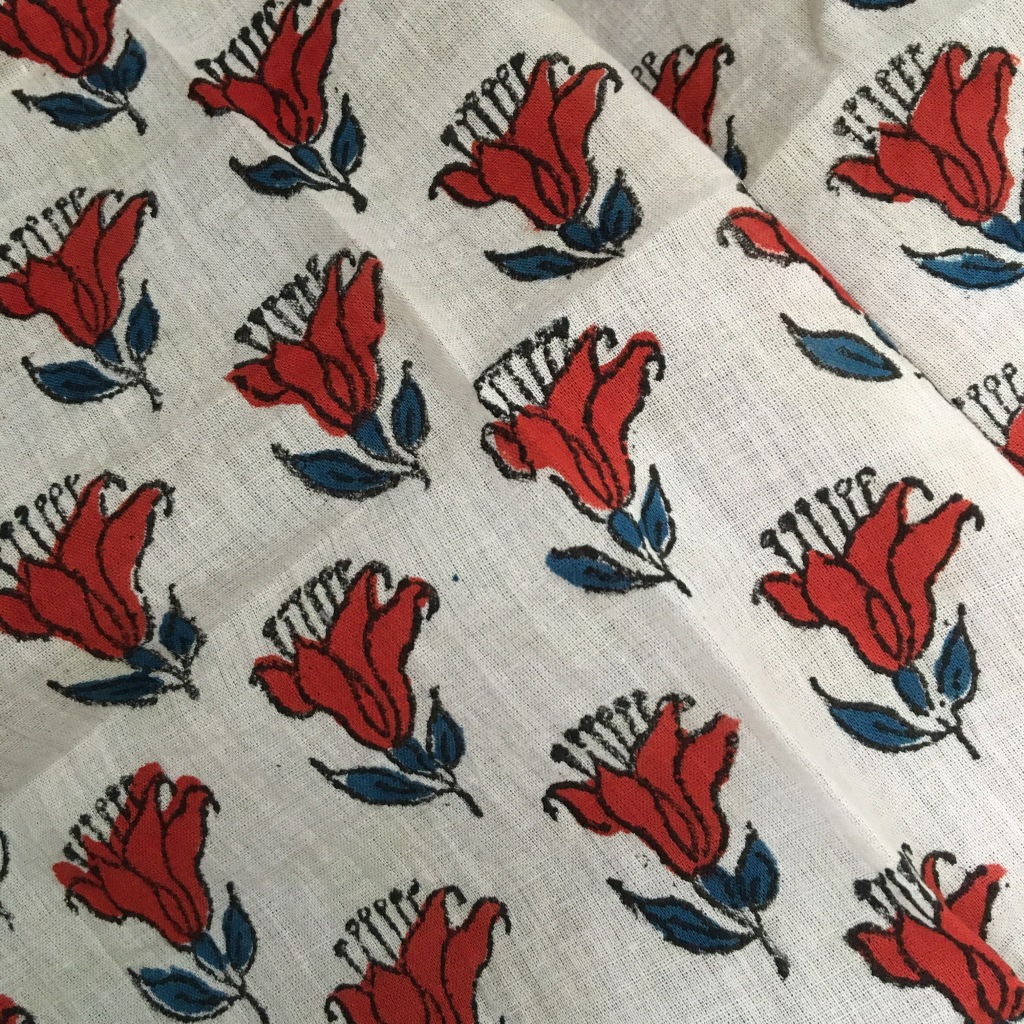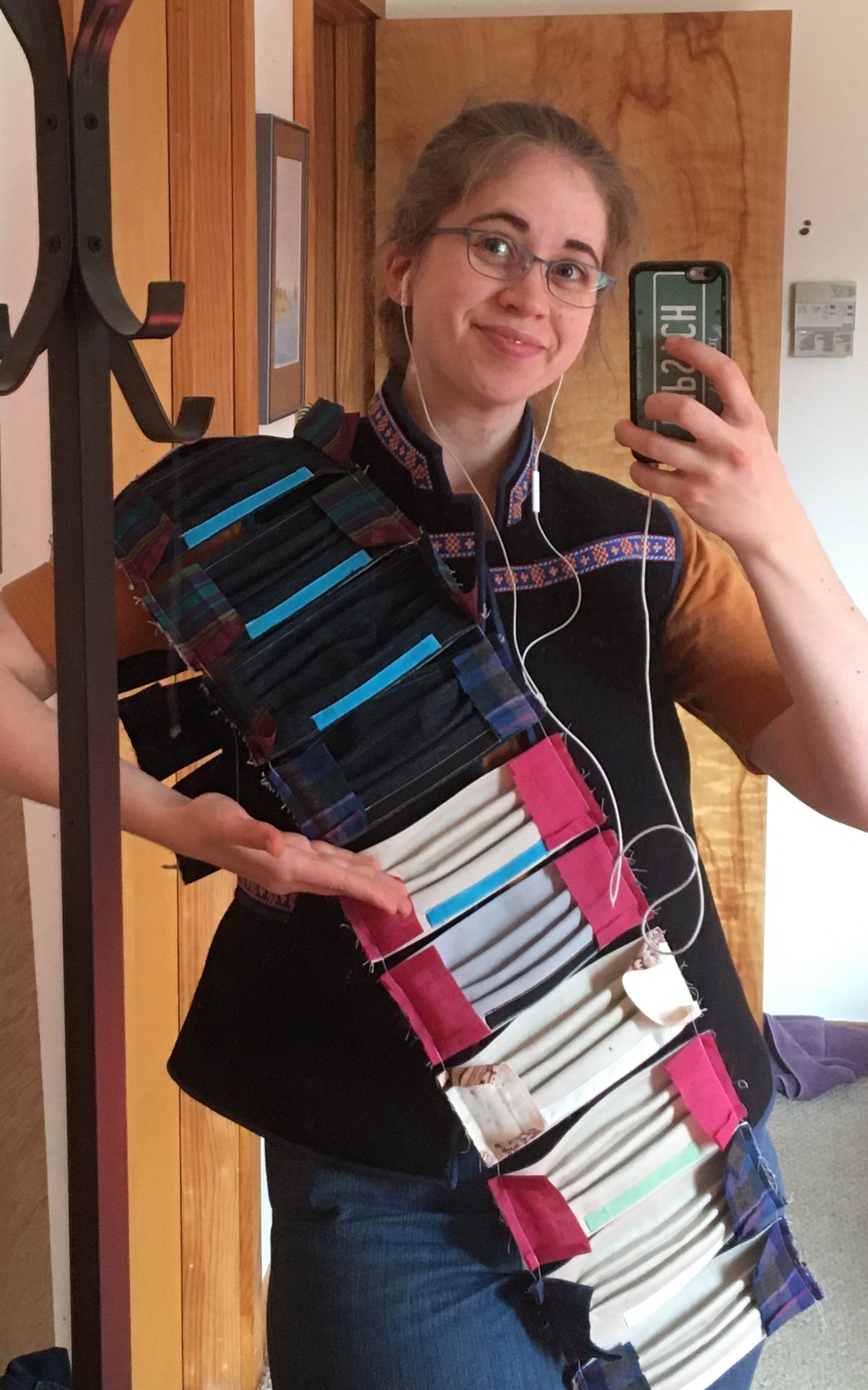Just now I came upstairs because I got that feeling in my hands and my heart like I ought to be doing something creative. It’s Friday night. The possibilities ticked through my head – I could do some research into 19th century knitting mills, or I could draw something, or start a sewing project. Or you could make some masks – that’s a sewing project. My brain dutifully reminds me that I could be sewing and making money at the same time if I worked on some face masks. It’s a hard offer to turn up. Sewing face masks has made up a solid portion of my income for the past year and it’s the only sort of paid work that’s even vaguely fun at 7:00pm on a Friday. On top of that, it’s surprisingly hard to find the energy for other projects. This is one of the most pronounced ways I’ve felt the drain of the pandemic – I struggle to feel creative in ways that used to feel second nature.

I’ve got a custom mask order to work on tonight. Someone from Instagram has sent me a scrap of lovely block printed cotton and asked if I would sew it up into one of my Face Space Masks. The background is white, which is good news, because I can make it as part of a batch of other primarily white masks and I won’t have to change thread colors.
Making masks isn’t truly creative work, it’s really more like repetitious manufacturing. But for someone who takes pride in expert handling of materials, it’s still satisfying – soothing even. I also can’t help but think of it as a learning opportunity (research!). For someone who studies craft work, it’s hard to resist analysing what I’m doing as I do it.
It’s been a long year and as I’ve stitched, I’ve thought about mask making from a staggering number of perspectives. Last March I saw women sewers of all stripes recruited to help handle a national emergency with their sewing machines and fabric stashes. There was not, at first, any money for this labor. It was sewing: a skill learned in Home Economics; part of the Western world’s ongoing love affair with divorcing women’s “home” labor from economic value. There was an expectation that we would just help. This was the first thing I considered: mask making was a gendered thing. Gendering effects perceived economic value.

At first I sewed a few masks for a local effort but was frustrated by the poor choice of materials and the terrible fit of the design. I stayed home, read every article I could find on fabric masks, and worked up my own pattern. Friends started asking for masks and I started selling them. First for five, then seven, then ten, then twelve dollars a piece. I intended to fully compensate myself* for my time, but at first I didn’t think to include the time it took to sell and ship masks. Here was the second thing I thought about: what my time is worth and the difference between just sewing masks and running business.
By this time I was making dozens of masks at once. I was confident in my design, but I was discovering bottlenecks and pain points in my manufacturing process. I re-thought things: it turned out there were steps I could skip without compromising quality and times when I could make many pieces at once. I’d never done this type of repetitive production work before and I spent a lot of time at my sewing machine thinking about the generations of textile laborers who have done similar through the ages. What does it mean to be “efficient” by doing the same thing 50 times in a row? It took a toll on my body and I ached more for their aching bodies. I thought about being part of this long chain of makers and where my own work fell on the spectrum which starts with craft and ends with manufacturing.

Fall came. I got bored of making masks but not of making money. I offered to make custom masks for folks and a friend asked if I could design a singer’s mask. The idea was a mask with more space and a structure that prevented it from being sucked into your mouth on the inhale. There were already designs out there for this type of thing, but I’d been making masks for half a year at this point and I wanted a design that I would enjoy sewing, so I came up with a pattern that replaced seaming with pleats and in so doing eliminated all but one trip to the iron. It is a good design, and not just for singers. It gave you more space for your face. I called it a “Face Space Mask.” I thought: innovation feels good. Making people’s lives easier feels even better.
It’s late April 2021. I’ve been making face masks for a year. One of the truly wonderful things about sewing work, especially the repetitive and not particularly creative kind, is that it gives you time to think. I am not glad that we’ve been living through a pandemic, and there are lots of things I would have rather spent the past year making than face masks, but I am glad to have found in that experience an opportunity to think about craft knowledge, gender, and labor. I am glad to have learned about running my own business and to have had an opportunity to make many, many people’s lives easier in one small way.
And tonight I’ve let my sewing machine rest in favor of the keyboard and this long-neglected (but not un-thought-of) blog. I am looking forward to the return of people’s smiles. I hope the creative itch that drew me to write tonight is a foreshadowing of a near future with fewer masks in it.
In the mean time, I’d hardly be the business woman I’ve grown to be if I didn’t suggest you go buy one of my masks.
—
*A few months into the pandemic a young woman I am friends with asked me about selling face masks. She was sewing masks for neighbors and she wasn’t sure how much to charge. We talked about the value of her skilled labor and the other expenses she ought to consider. I told her how much I pay myself, because I think it’s good for people to have a sense of what others earn. I’ve got many years of training and experience in sewing work. I pay myself $35 an hour, knowing that I will give 30% of that back to the government in self-employment taxes and that I do not have an employer covering the cost of health insurance. Your skill has value, friends. We live in a world that requires money. Don’t underpay yourself.
Hi! There is a conference CFP coming up that you might consider submitting a talk on this subject. It is “Women & Masks” https://sites.bu.edu/womenandmasks/
LikeLiked by 1 person
Thank you! That’s a wonderful suggestion.
LikeLike